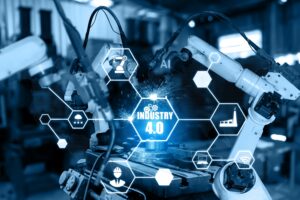
In the dynamic world of manufacturing, the convergence of IT and OT has become increasingly important. Bridging the gap between these two domains offers numerous benefits that can significantly enhance efficiency and productivity in the manufacturing sector. In this article, we will deep dive into the advantages of IT-OT convergence and explore how it is transforming the manufacturing industry.
What is IT/OT convergence?
IT traditionally deals with data processing, storage, and information management, whereas OT focuses on controlling the physical processes of manufacturing. Bridging the gap between these two creates a synergy that goes beyond the sum of their parts.
IT/OT convergence is the integration of information technology (IT) systems, primarily focused on data-centric computing, with operational technology (OT) systems, which monitor and control events, processes, and devices in enterprise and industrial operations.
Traditionally, these two worlds—physical machinery and digital information—have operated separately. However, with advancements in technologies like the Internet of Things (IoT) and big data analytics, there’s a systematic merging of the digital and physical realms. This convergence enables a unified environment where business processes, insights, and controls seamlessly come together, bridging the gap between traditionally disparate domains.
Types of IT/OT convergence
Convergence in IT/OT is a multifaceted effort, not a singular initiative. It encompasses three key categories:
- Process Convergence: Involves aligning workflows between IT and OT departments, necessitating organizational changes to enhance communication and accommodate each other’s projects. For instance, established IT data storage processes may be adapted for converging OT systems.
- Software and Data Convergence: Focuses on integrating front office software and data to meet OT requirements. This entails technical adjustments to the network architecture, such as implementing new tools for gathering OT data and combining it with IT data for analysis.
- Physical Convergence: Encompasses updating or retrofitting physical devices with new hardware to integrate IT into traditional OT. This operational convergence involves ongoing maintenance and may include the purchase of new OT systems or aftermarket devices to facilitate data communication and control.
Benefits of IT-OT Convergence in Manufacturing
1. Improved Visibility and Control over Operations:
One of the key benefits of IT-OT convergence is improved visibility and control over operations. By integrating IT systems with OT processes, manufacturers gain real-time insights into production data, enabling them to make informed decisions and optimize their operations accordingly. This results in reduced downtime, enhanced asset utilization, and streamlined processes. By eliminating manual and paper-based systems, manufacturers can achieve greater efficiency and accuracy in their operations.
2. Seamless Communication and Collaboration:
Furthermore, IT-OT convergence facilitates seamless communication and collaboration across different departments within a manufacturing organization. Sharing information and coordinating activities becomes more efficient, leading to improved coordination and faster response times. By breaking down silos, departments can work together more cohesively, leading to better coordination and ultimately improved customer satisfaction.
3. Leveraging Emerging Technologies:
In addition, the integration of IT and OT enables manufacturers to leverage technologies such as the Internet of Things (IoT), big data analytics, and artificial intelligence (AI). These technologies have the potential to revolutionize traditional manufacturing practices, enabling predictive maintenance, automated workflows, and real-time monitoring. By harnessing the power of these technologies, manufacturers can optimize production, minimize downtime, and reduce operational costs. Furthermore, AI-powered analytics can uncover valuable insights from vast amounts of data, paving the way for data-driven decision-making and continuous improvement.
Overcoming Challenges in Implementing IT-OT Convergence in Manufacturing
While the benefits are substantial, integrating IT and OT comes with its challenges. It requires careful planning, collaboration between IT and OT teams, and a clear understanding of the organization’s goals and objectives.
Additionally, manufacturers should invest in robust cybersecurity measures to protect their connected systems and devices from potential cyber threats. Many OT systems lack standardized communication and remote accessibility, leaving them vulnerable.
Legacy system compatibility, and the need for a skilled workforce are hurdles that must be also addressed to fully realize the potential of IT-OT convergence. Additional challenges include:
- Process Convergence: Reorganizing siloed IT and OT departments to manage converged technology poses organizational hurdles.
- Secure IoT Implementation: Communication gaps and limited security knowledge in OT departments can result in dangerous security gaps with IoT deployments.
- Training: Limited standardized courses for manufacturing process control create knowledge gaps, especially in older systems and staff.
- Integration with Existing Systems: Organizations may be tempted to replace technologies instead of modernizing existing OT, undermining the cost efficiency that convergence offers. The essence of convergence is doing more with existing resources.
By addressing these challenges upfront, manufacturers can successfully implement IT-OT convergence and reap the rewards.
Future Trends and Opportunities
As technology evolves, the future of IT-OT convergence holds exciting possibilities. Edge computing, 5G connectivity, and the continued evolution of AI and IoT are expected to play pivotal roles in shaping the manufacturing landscape. Manufacturers that embrace this convergence and stay at the forefront of technological advancements will be well-positioned to seize these opportunities and thrive in the digital era.
Conclusion:
In today’s digital age, IT-OT convergence is no longer an option but an imperative for manufacturers looking to stay competitive. By bridging the gap between IT and OT, businesses can unlock a multitude of benefits, including improved visibility, streamlined processes, and enhanced collaboration. Moreover, the integration of emerging technologies further amplifies the potential for transformative changes in the manufacturing industry. Embrace the power of IT-OT convergence, and propel your organization towards a future of increased efficiency, productivity, and success in the ever-evolving manufacturing landscape.
The convergence of IT and OT in manufacturing, powered by no-code solutions like those offered by NC-Vision, is not just a trend—it’s the future. Are you ready to take the first step?



Made for production, manufacturing, and beyond:
Discover how NC-Vision can help you bridge the gap betwwn IT and OT to support data-driven decisions and increase business efficiency. Don’t let complexity hold you back. Schedule a free platform tour today and see the difference for yourself.
NC-Vision is committed to helping the manufacturing industry make the most of no-code software development. We offer a range of no-code solutions that enable companies to quickly and easily create custom solutions that are tailored to their needs. Our tools allow companies to create solutions faster, more cost-effectively, and with more customization than ever before.












